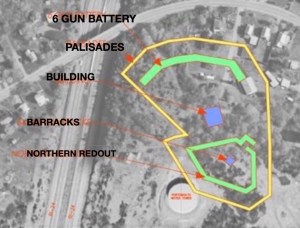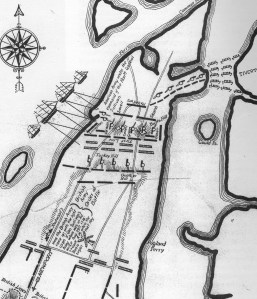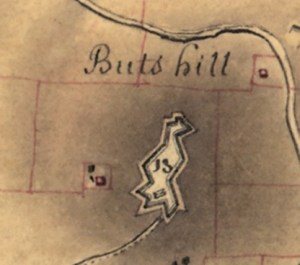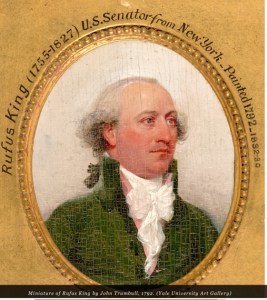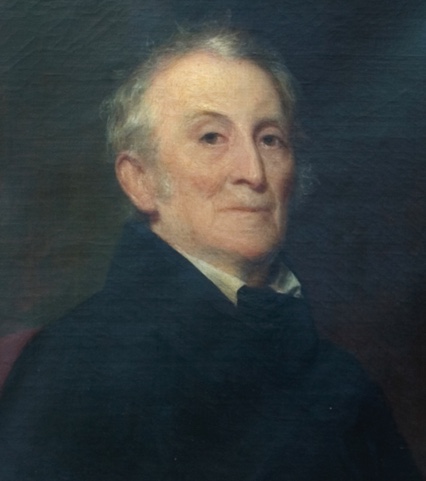Butts Hill Fort (or Windmill Hill Fort) evolved along the way. The British called this area Windmill Hill because it was a traditional site for a windmill. The Americans called this area “Butts Hill” after the John Butts family that held the land when the war began. The outlines you see at the fort date from the improvements made by the French and Americans in 1780 to 1781. It is at this point that the fortifications at Butts Hill became Butts Hill Fort.
1776: The Portsmouth Militia begins to fortify Butts Hill. We know fortifications were there in 1776, but some sources date the defenses there to 1775. The hill had a commanding view of the Bristol Ferry and the Howland Ferry to Tiverton. The oldest section of the fort is the North ramparts.
December. 8, 1776: The British land on Aquidneck Island. The British began to make improvements on what they call the Windmill Hill redoubt.
December. 30, 1776: The British begin to build a guard house.
From the diary of British soldier Frederick Mackenzie: ”The redoubt constructed by the Rebels above Bristol Ferry, and abandoned by them, is ordered to be repaired and a guard house to be erected therein for the accommodation of the advanced post. It is a much better situation for the advanced guard than that they are now in…
September 12-16, 1777: Town inhabitants are forced to work on Butts Hill Fort. Sept 12, 1777: “As the works intended to be made for the defense of the North Part of the Island, require a good many workmen to complete them, and the duty of the Soldiers is rather severe, General Pigot sent a summons this day to the Inhabitants of the township of Portsmouth to assemble on the 15th instant at Windmill Hill in order to assist in carrying them on. They are required to work three days in the week.” (From Mackenzie diary).
September 17- November 12, 1777: British work on barracks for 200 men.
December 30 – 31, 1777: British plans call for a 6-gun battery, redoubt for 100 men and a new barracks for 300 men.
May 1-May 6th, 1778: British 54th Regiment constructs redoubt around barracks.
May 8 – May 9, 1778: Landgrave and Ditfourth posted a fortification with 1000 men.
August 9, 1778: Fearing an attack, British forces abandoned Butts Hill and General Pigot withdrew his forces to Newport as the French were landing on Conanicut. Patriot Sullivan discovered that the British had abandoned Butts Hill, so he crossed over to Aquidneck and occupied the high fortifications. He called for the heavy cannon at Fox Point to be moved to Portsmouth. Sullivan was supposed to wait until August 10.
August 11, 1778: Most of the almost 10,000 American troops were camped about Butts Hill. The diary of Rev. Manasseh Cutler who served as chaplain for American General Titcomb’s Brigade, provides a few glimpses of what was going on around Butts Hill. He wrote on August 11th that at 4 o’clock the whole army paraded and passed in review by the general officers. “The right wing of the army was commanded by General Greene and the left by the Marquis de Lafayette.”
August 16, 1778: As the Americans built earthworks and dug trenches toward Newport, American reserves and the sick who were healthy enough to do garrison work remained at Butts Hill which served as Sullivan’s headquarters.
August 24, 1778: Americans now know that the British fleet is coming and that it would be at least three weeks before the French would arrive. They begin to send their heavy cannon back to northern locations like Butts Hill. From Cutler’s diary – “As much of the heavy baggage moved off last night as possible. A body of men retreated to strengthen the works at Butts’ Hill. At the lines – heavy fire – army preparing to retreat.”
August 28, 1778: ”On the evening of the 28th we moved with our stores and baggage, which had not been previously sent forward, and about two in the morning encamped on Butts’s Hill, with our right extending to the west road, and left to the east road; the flanking and covering parties ____further towards the west road on the right and left.” (From Sullivan’s letter to Congress.”
August 29 – August 30, 1778: Sullivan describes his retreat from Butts Hill. “As our sentries were within 200 yards of other, I knew it would require the greatest care and attention. To cover my design from the enemy, I ordered a number of tents to be brought forward and pitched in sight of the enemy, and almost the whole army employed themselves in fortifying the camp. The heavy baggage and stores were falling back and crossing through the day; at dark, the tents were struck, the light baggage and troops passed dawn, and before twelve o’clock the main army had crossed with the stores and baggage.”
September 1, 1778: British return to Windmill Hill (Butts Hill).
December 1779 British depart Rhode Island (Aquidneck). Americans regained possession of Butts Hill.
July 11, 1780: The French come to Newport. Some French soldiers garrisoned at Butts Hill.
Summer through Fall 1780: The allied French and American forces felt secure, but they continued to prepare to defend the island. On Butts Hill there were American troops assigned to support the work of the French troops in restoring the fortifications. Through the summer and fall of 1780, Butts Hill was actively being enclosed and made into a fort by the Americans and their French allies. This is the fort shape we recognize today.
December 8, 1780. Rochambeau and Governor William Greene exchange letters. Greene accepts the offer of the French to send 24 men to guard Butts Hill Fort so that Col. Greene’s regiment may join Washington’s army in New York.
September 19, 1782: Rhode Island resolution passed that authorized Col. Archibald Crary to call on the commanding officer at Newport for help in removing the cannon and stores from Butts Hill and move them to Providence.
June 1783, Rhode Island resolution passed to authorize William Anthony, Jr. “to sell at public venue the gates, timber, &c on Butts’s Hill in Portsmouth.” (Bartlett, Records IX, p. 709)
1907 – Dyer family farm and surrounding area is platted for 200 house lots.
1920s: Rev. Roderick Terry conveyed to Newport Historical Society, pieces of the Butts Hill land in 1923, 1924, and 1932. Butts Hill Fort is dedicated to the memory of those who fought in the Battle of Rhode Island.
1968: Butts Hill Land transferred from Newport Historical Society to the State. The state transferred land to the Town of Portsmouth.
1974: Butts Hill Fort, as part of the Battle of Rhode Island site, was listed in the National Register of Historic Places.
April, 2021. The National Park Service has listed Butts Hill Fort as a location on the Washington – Rochambeau Route National Historic Trail.

